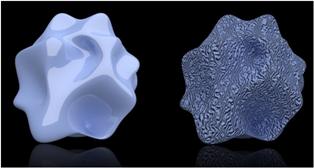
A paper published in NeuroImage by a recently graduated doctoral researcher explores how viewing an object can induce brain activity related to touch.
Looking at objects gives us an intuitive idea of how their surfaces would feel to touch: Steel objects would feel smooth and cold; fabric would feel soft and warm; and cement would feel hard and rough. It is unclear how our brain uses information acquired solely by vision to derive sensations associated with another sensory modality, touch. One possibility is that we remember touch sensations from previous interactions with similar materials. Could such memories re-create the sensation of touching an object?
A paper published in NeuroImage by recently graduated doctoral researcher Hua-Chun Sun, in collaboration with Andrew E. Welchman, Dorita H.F. Chang, and Massimiliano Di Luca, investigates whether viewing objects with different surface structures causes activity in the neural circuits responsible for touch sensation located at the fingertips. Participants viewed colored shapes with a distinct type of surface: rough or smooth. Brain activation captured through fMRI imaging demonstrated that viewing images of objects with rough or smooth surfaces changes brain activation that processes touch stimuli in the fingertips. In fact, the team could determine whether participants viewed rough objects just by analysing brain activation related to the fingertips. On the contrary, other aspects of visual appearance, like flat patterns of paint, are not effective in eliciting activation in the fingers area; and neither is asking participants to imagine a tactile sensation without seeing the surface of the object. These results suggest a close link between the look and feel of objects encountered in daily life.
The brain uses visual signals to generate cross-modal expectations of the sensory consequences of interacting with objects. This is likely useful for movement planning and movement control; eg, to generate appropriate force and precision when picking up an object or to quickly adjust grip if the friction is different than what was expected.
Full image caption: Two objects with similar shape, but different surface roughness. Areas in the brain that normally process touch information at the fingertips show different activation while participants only looked at the two objects.
Reference:
Sun, H.-C., Welchman, A. E., Chang, D.H.F., Di Luca, M. (2016). Look but don't touch: Visual cues to surface structure drive somatosensory cortex, NeuroImage,128, 353–361. doi:10.1016/j.neuroimage.2015.12.054